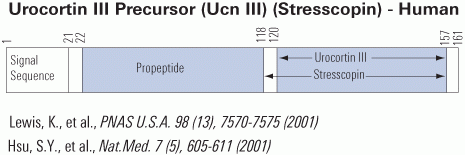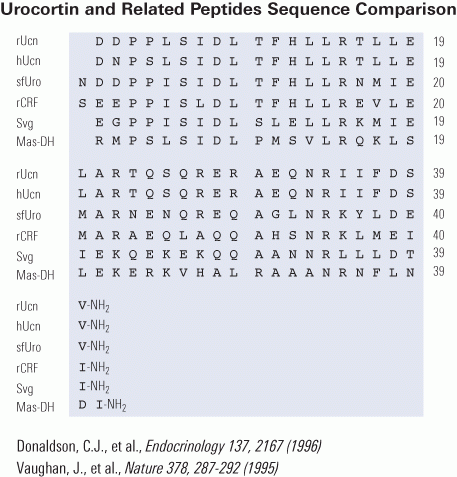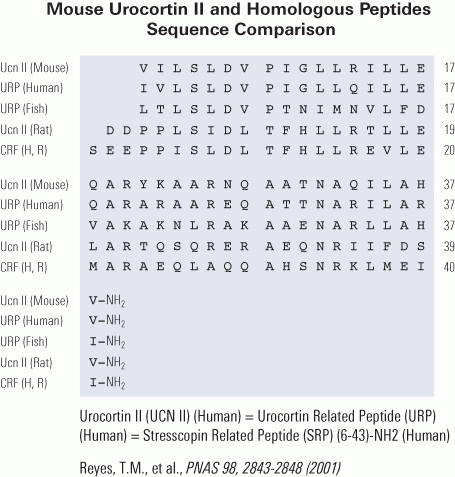
    |
  |
Corticotropin-releasing factor (CRF) has been hypothesized to modulate consummatory behavior through the Type 2 CRF (CRF(2)) receptor. However, behavioral functions subserved by the CRF(2) receptor remain poorly understood. Recently, human urocortin II (hUcn II), a selective CRF(2) receptor agonist, was identified. To study the effects of this neuropeptide on ingestive behavior, we examined the effects of centrally infused hUcn II (i.c.v. 0, 0.01, 0.1, 1.0, 10.0 &mgr;g) on the microstructure of nose-poke responding for food and water in nondeprived, male rats. Malaise-inducing properties of the peptide were monitored using conditioned taste aversion (CTA) testing. To identify potential sites of action, central induction of Fos protein expression was examined. hUcn II dose dependently reduced the quantity and duration of responding for food and water at doses lower (0.01-1.0 &mgr;g) than that forming a CTA (10 &mgr;g). Effects were most evident during hours 4 to 6 of the dark cycle. Meal pattern analysis showed that hUcn II potently (0.1 &mgr;g) increased the satiating value of food. Rats ate and drank smaller and shorter meals without changing meal frequency. Rats also ate more slowly. hUcn II induced Fos in regions involved in visceral sensory processing and autonomic/neuroendocrine regulation and resembling those activated by appetite suppressants. hUcn II is a promising neuropeptide for investigating the role of the CRF(2) receptor in ingestive behavior.
Inoue K, Valdez GR, Reyes TM, et al. Human urocortin II, a selective agonist for the type 2 corticotropin-releasing factor receptor, decreases feeding and drinking in the rat. J Pharmacol Exp Ther. 2003;305(1):385-93.
Urocortin (Ucn) III, or stresscopin, is a high affinity ligand for the type 2 corticotropin-releasing factor (CRFR2) receptor recently identified in rodents and human. Ucn III was initially identified as a neuropeptide expressed in discrete areas in the brain. In the present study, we demonstrate that Ucn III is expressed in pancreatic beta-cells and in a mouse beta-cell line, MIN6. Ucn III secretion from the cells was measured using a highly specific RIA, and we found that high potassium, forskolin, or high glucose can stimulate Ucn III secretion from these cells. In vivo studies showed that rats receiving an iv Ucn III injection had a significant elevation of plasma glucagon followed by plasma glucose levels compared with rats receiving vehicle. Ucn III injections also result in an increase in plasma insulin levels. The observed effects of Ucn III were blocked by pretreatment with a CRFR2 antagonist, astressin(2)-B. Furthermore, Ucn III stimulated glucagon and insulin release from isolated rat islets, and astressin(2)-B abolished the effects of Ucn III, in keeping with a CRFR2-mediated mechanism. Taken together, the present studies suggest pancreatic Ucn III acting through CRFR2 is involved in the local regulation of glucagon and insulin secretion.
Li C, Chen P, Vaughan J, et al. Urocortin III is expressed in pancreatic beta-cells and stimulates insulin and glucagon secretion. Endocrinology. 2003;144(7):3216-24.
Corticotropin-releasing factor (CRF) has been hypothesized to modulate consummatory behavior through the Type 2 CRF (CRF(2)) receptor. However, behavioral functions subserved by the CRF(2) receptor remain poorly understood. Recently, human urocortin II (hUcn II), a selective CRF(2) receptor agonist, was identified. To study the effects of this neuropeptide on ingestive behavior, we examined the effects of centrally infused hUcn II (i.c.v. 0, 0.01, 0.1, 1.0, 10.0 micro g) on the microstructure of nose-poke responding for food and water in nondeprived, male rats. Malaise-inducing properties of the peptide were monitored using conditioned taste aversion (CTA) testing. To identify potential sites of action, central induction of Fos protein expression was examined. hUcn II dose dependently reduced the quantity and duration of responding for food and water at doses lower (0.01-1.0 micro g) than that forming a CTA (10 micro g). Effects were most evident during hours 4 to 6 of the dark cycle. Meal pattern analysis showed that hUcn II potently (0.1 micro g) increased the satiating value of food. Rats ate and drank smaller and shorter meals without changing meal frequency. Rats also ate more slowly. hUcn II induced Fos in regions involved in visceral sensory processing and autonomic/neuroendocrine regulation and resembling those activated by appetite suppressants. hUcn II is a promising neuropeptide for investigating the role of the CRF(2) receptor in ingestive behavior.
Inoue K, Valdez GR, Reyes TM, et al. Human urocortin II, a selective agonist for the type 2 corticotropin-releasing factor receptor, decreases feeding and drinking in the rat. J Pharmacol Exp Ther. 2003;305(1):385-93.
Peripheral CRF inhibits gastric emptying and stimulates colonic motor function in rats. We investigated the role of CRF(1) and CRF(2) receptors in i.p. CRF-induced alterations of gut transit in conscious mice using selective CRF(1) and CRF(2) ligands injected i.p. Gastric emptying 2 h after ingestion of a solid chow meal and colonic transit (time to expel a bead inserted into the distal colon) were determined simultaneously. Rat/human (r/h)CRF, which has CRF(1) > CRF(2) binding affinity, decreased distal colonic transit time at lower doses (6-12 microg/kg) than those inhibiting gastric emptying (20-60 microg/kg). Ovine CRF, a preferential CRF(1) receptor agonist (6-60 microg/kg), reduced significantly the colonic transit time without altering gastric emptying, whereas the selective CRF(2) receptor agonists mouse urocortin II (20-60 microg/kg) and urocortin III (120 microg/kg) inhibited significantly gastric emptying without modifying colonic transit. The CRF(1)/CRF(2) receptor antagonist, astressin (30-120 microg/kg), dose dependently prevented r/hCRF (20 microg/kg)-induced inhibition of gastric emptying and reduction of colonic transit time. The selective CRF(1) receptor antagonists, NBI-27914 (C(18)H(20)Cl(4)N(4)C(7)H(8)O(3)S) and CP-154,526 (butyl-[2,5-dimethyl-7-(2,4,6-trimethylphenyl)-7H-pyrrolo[2,3-d]pyrimidin-4-yl]ethylamine) (5-30 mg/kg), dose dependently blocked r/hCRF action on the colon without influencing the gastric response, whereas the CRF(2) receptor antagonist, antisauvagine-30 (30-100 microg/kg), dose dependently abolished r/hCRF-induced delayed gastric emptying and had no effect on colonic response. These data show that i.p. r/hCRF-induced opposite actions on upper and lower gut transit in conscious mice are mediated by different CRF receptor subtypes: the activation of CRF(1) receptors stimulates colonic propulsive activity, whereas activation of CRF(2) receptors inhibits gastric emptying.
Martínez V, Wang L, Rivier JE, Vale W, Taché Y. Differential actions of peripheral corticotropin-releasing factor (CRF), urocortin II, and urocortin III on gastric emptying and colonic transit in mice: role of CRF receptor subtypes 1 and 2. J Pharmacol Exp Ther. 2002;301(2):611-7.
Human urocortin (hUcn) II is a new member of the corticotropin-releasing factor (CRF) family that selectively binds to the CRF(2) receptor. We investigated the CRF receptors involved in mediating the effects of hUcn II and human/rat CRF (h/rCRF) on gut transit. Gastric emptying, 4 h after a solid meal, and distal colonic transit (bead expulsion time) were monitored simultaneously in conscious rats. CRF antagonists were given subcutaneously 30 min before intravenous injection of peptides or partial restraint (for 90 min). hUcn II (3 or 10 microg/kg i.v.) inhibited gastric emptying (by 45% and 55%, respectively) and did not influence distal colonic transit. The CRF(2) peptide antagonist astressin(2)-B blocked hUcn II action. h/rCRF, rat Ucn, and restraint delayed gastric emptying while accelerating distal colonic transit. The gastric response to intravenous h/rCRF and restraint was blocked by the CRF(2) antagonist but not by the CRF(1) antagonist CP-154,526, whereas the colonic response was blocked only by CP-154,526. None of the CRF antagonists influenced postprandial gut transit. These data show that intravenous h/rCRF and restraint stress-induced delayed gastric emptying involve CRF(2) whereas stimulation of distal colonic transit involves CRF(1). The distinct profile of hUcn II, only on gastric transit, is linked to its CRF(2) selectivity.
Million M, Maillot C, Saunders P, Rivier J, Vale W, Taché Y. Human urocortin II, a new CRF-related peptide, displays selective CRF(2)-mediated action on gastric transit in rats. Am J Physiol Gastrointest Liver Physiol. 2002;282(1):G34-40.
A vast number of intensive studies have been undertaken to clarify the mechanisms of energy balance. This study was undertaken to investigate the effect of urocortin, an endogenous ligand for corticotropin-releasing factor (CRF) type 2 receptor, on oxygen consumption in lean and genetically obese (ob/ob) mice. Oxygen consumption was measured after intraperitoneal injection in unrestrained mice at an environmental temperature of 22 degrees C of one of the following: urocortin, deamidated form of urocortin (urocortin OH) or CRF. The intraperitoneal injection of urocortin (0.3-3 nmol) dose-dependently decreased oxygen consumption in lean mice. The inhibitory effect induced by urocortin was more potent than that induced by CRF or urocortin OH. The ranking potency was urocortin > urocortin OH > CRF. Urocortin significantly reduced oxygen consumption in ob/ob mice as well as in lean mice. These results suggest that urocortin decreases oxygen consumption, and that the CRF type 2 receptor may influence energy balance in lean and ob/ob mice.
Asakawa A, Inui A, Ueno N, et al. Urocortin reduces oxygen consumption in lean and ob/ob mice. Int J Mol Med. 2001;7(5):539-41.
BACKGROUND & AIMS: Gastric emptying plays an important role in regulating food intake. This study was designed to investigate whether intraperitoneally injected urocortin reduces gastric emptying, feeding, and body weight in lean and ob/ob obese mice.METHODS: Food intake and body weight were measured after intraperitoneal injections of one of the following: urocortin, deamidated form of urocortin (urocortin OH), corticotropin-releasing factor (CRF), CRF6-33, cholecystokinin octapeptide (CCK-8), and leptin in 16-hour food-deprived animals. Gastric emptying was assessed 2, 4, or 8 hours after intraperitoneal injection. Repeated injections of urocortin were continued for 5 days in ob/ob mice.RESULTS: Urocortin (0.003-3 nmol) dose-dependently and potently decreased food intake and body weight gain in lean mice. The ranking order of potency was urocortin > urocortin OH >/= CRF > CCK-8 > CRF6-33 > leptin. Gastric emptying was also potently reduced by urocortin with a similar ranking order of potency of urocortin > CRF > urocortin OH > CCK-8. Simultaneous administration of urocortin and CRF receptor antagonist, alpha-helical CRF9-41, blocked the effects of urocortin. Urocortin reduced food intake and body weight gain, as well as the rate of gastric emptying, in ob/ob mice, which was significantly faster than that of lean mice. Five daily injections of urocortin significantly lowered body weight and improved glycemic control in ob/ob mice.CONCLUSIONS: The urocortin-induced decrease in food intake and body weight in lean and ob/ob mice is closely related to gastric emptying and opens new possibilities for the treatment of obesity.
Asakawa A, Inui A, Ueno N, Makino S, Fujino MA, Kasuga M. Urocortin reduces food intake and gastric emptying in lean and ob/ob obese mice. Gastroenterology. 1999;116(6):1287-92.
| Catalog# | Product | Standard Size | Price |
|---|---|---|---|
| 019-30 | Urocortin II (Human) | 100 µg | $189 |
| 019-28 | Urocortin III (Human) | 100 µg | $189 |
| 019-14 | Urocortin (Human) | 100 µg | $202 |
| 019-34 | Urocortin II (Rat) | 100 µg | $202 |
| H-019-29 | Urocortin III (Mouse) - Antibody | 100 µl | $571 |
| G-019-27 | Stresscopin Related Peptide (SRP) (Human) - Purified IgG Antibody | 200 µg | $571 |
| G-019-30 | Urocortin II (Human) - Purified IgG Antibody | 200 µg | $571 |
| 019-26 | Stresscopin (SCP) (Human) | 100 µg | $189 |
| EK-019-30 | Urocortin II (Human) - EIA Kit | 96 wells | $570 |
| FEK-019-15 | Urocortin (Rat, Mouse) - Fluorescent EIA Kit | 96 wells | $624 |
Social Network Confirmation